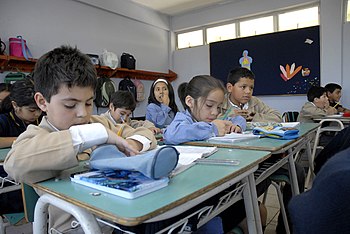
For several years, the number of high school graduates who return to college is on the decline. In 2010, the average number full-time freshmen who returned to college for their first year was 35%. This is down from 21% in 2011. Despite the decline in enrollments, the percentage of Americans age 30-64 who have been enrolled in postsecondary education remains relatively steady over five years. However, a major decline in the number of people completing a bachelor's degree is expected by the Western Interstate Commission on Higher Education.
While college enrollment rates can vary depending on race and socioeconomic status they are generally higher among students from the richest quintile. Additionally, wealthier students tend to go for an associate's or two-year degree, while those from the lower income bracket may choose to enroll in four-year programs. This trend is evident more for students of color then for whites. While students of color are more likely, and less likely to be accepted into college, minority students are less likely than peers who are not from a minority to continue their education.

There have been many factors that contribute to the declining college enrollment. A large number of students who come from poor families can't afford college, which is one reason they quit. Low-income students often cannot afford to go to college near home. People who live in rural areas are often faced with additional socioeconomic problems. Students from well-off families can find better jobs and education than students with lower incomes.
33% of U.S. high school students go to college seeking a job. These figures are based off data from the National Student Clearinghouse Research Center. These figures are compiled from data collected from more than 3,600 institutions. Unfortunately, the federal figures do not include transfers. Consequently, the data does not accurately reflect the number of high school graduates pursuing college.
Also, college dropout rates among first-generation students are higher than for those with parents with university degrees. This is a concern for colleges and universities as it means that there are fewer students to choose from and that it is harder to replace them. Some universities are attempting to address the problem by focusing on changing their business model. UC Berkeley, for instance, is one university that has been able increase the proportion of students who graduate after two years.
The United States should be concerned about a falling number of high-school graduates who attend college. This will likely reduce the country's ability to compete and lower quality of life. Only 51 percent of Americans who have graduated high school are currently enrolled in college. According to The Hechinger Report, an independent news organization that focuses on inequality, the proportion of college-bound students will fall to 46% by 2020.

Colleges are particularly concerned about high school graduates not going to college. Colleges are more inclined to hire students from wealthy neighborhoods than high schools. Although many high school students enroll in college, not all of them end up with a bachelor's. As a result, their earnings and prospects are reduced.
FAQ
What is a Trade School?
People who are not able to succeed at traditional higher education institutions can earn a degree through trade schools. They provide career-oriented programs to help students prepare for specific occupations. These programs allow students to complete two years' worth of coursework in one semester. Then they can enter into a paid apprenticeship program that teaches them a specific skill set and provides on-the job training. Trade schools include vocational schools, technical colleges, community colleges, junior colleges, and universities. Some trade schools also offer associate degree programs.
Is it difficult for a teacher to become?
You must be a teacher. You will need to devote a significant amount of time to your studies.
You can expect to work 40 hours per semaine while earning your degree.
You will also need to find a job that suits your schedule. Many students report difficulty finding part-time jobs that work around their school schedules.
After you have been offered a permanent position, you will be expected to teach classes throughout the day. Sometimes, you may need to travel to other schools during the week.
What is the main difference between schooling and college?
Schools are typically divided into classes or grades with a teacher who teaches students. Colleges, which are often larger and offer more specialized classes, may also include university-level programs. The majority of schools focus on core subjects, while colleges offer more specialized programs. Both levels of education are designed to prepare students for higher-level study.
Homeschooling is for everyone.
Anyone can homeschool. No special qualifications are required.
It is possible for parents to teach their children after they have finished high school. Many families opt to have their children teach them while they are in college.
Parents who have less formal education may be able to teach their children.
Parents can become certified teachers after completing certain requirements. These requirements can vary from one state to the next.
Some states require that all homeschooled students pass a test before they graduate. Others do not.
Homeschooling parents should register their family at the local school district.
This involves filling out paperwork that is then submitted to the school board.
After registering, parents will be able to enroll their child in either public or privately-funded schools.
Some states allow parents to homeschool, but they must register their children with the government.
If you are a resident of one of these countries, you will have to ensure your children adhere to the state's compulsory attendance requirements.
Statistics
- They are more likely to graduate high school (25%) and finish college (116%). (habitatbroward.org)
- “Children of homeowners are 116% more likely to graduate from college than children of renters of the same age, race, and income. (habitatbroward.org)
- And, within ten years of graduation, 44.1 percent of 1993 humanities graduates had written to public officials, compared to 30.1 percent of STEM majors. (bostonreview.net)
- Among STEM majors, that number is 83.5 percent. (bostonreview.net)
- Globally, in 2008, around 89% of children aged six to twelve were enrolled in primary education, and this proportion was rising. (en.wikipedia.org)
External Links
How To
Where can you find a teacher job?
There are many teaching jobs available in public elementary and private schools.
A bachelor's degree at one of the following institutions is necessary to become a teacher.
-
A four-year college/university
-
A degree program for associates
-
Two-year community college programs
-
The combination of these types of programs
To be eligible for teacher certification, applicants must satisfy state requirements. These include passing standardized test and having a probationary period.
Most states require that candidates pass the Praxis II exam. This test measures the candidate's knowledge of reading, writing, mathematics, and language arts.
A lot of states also require applicants to have a specialized licence before they can be certified to teach.
These licenses are issued annually by the state boards of education.
Some states grant licenses to applicants without any additional testing. These cases require that the applicant contact the state board of education to confirm if the license is granted.
Some states don't grant licenses to applicants who haven't completed a masters degree program.
Some states permit individuals to apply directly at the state board or education for licensure.
The cost of licenses varies widely depending on their duration and the required coursework.
Some states only require a high school diploma while others require a bachelor’s degree.
Some states require training on specific topics, such literacy or child development.
Some states require candidates to have a master's degree in order to become licensed.
When applying for certification, many states ask prospective teachers about previous employment.
You may want to mention that you have been employed in another occupation on your application.
However, states are more than willing to accept previous work experience, regardless of the type of job.
It is possible to list your prior job title, position, as well as years of service.
This information can be very helpful for potential employers.
It shows that they have relevant skills.
While working, you may have learned new skills and acquired valuable work experience.
Employers can see this in your resume.